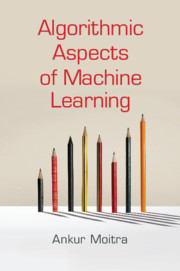Refine search
Actions for selected content:
48168 results in Computer Science
4 - A Musical Interlude
-
- Book:
- The Haskell School of Music
- Published online:
- 21 September 2018
- Print publication:
- 04 October 2018, pp 63-73
-
- Chapter
- Export citation
Acknowledgments
-
- Book:
- The Haskell School of Music
- Published online:
- 21 September 2018
- Print publication:
- 04 October 2018, pp xvi-xvi
-
- Chapter
- Export citation
11 - Proof by Induction
-
- Book:
- The Haskell School of Music
- Published online:
- 21 September 2018
- Print publication:
- 04 October 2018, pp 156-174
-
- Chapter
- Export citation
Index
-
- Book:
- The Haskell School of Music
- Published online:
- 21 September 2018
- Print publication:
- 04 October 2018, pp 381-384
-
- Chapter
- Export citation
Appendix A - The PreludeList Module
-
- Book:
- The Haskell School of Music
- Published online:
- 21 September 2018
- Print publication:
- 04 October 2018, pp 346-354
-
- Chapter
- Export citation
Bibliography
-
- Book:
- The Haskell School of Music
- Published online:
- 21 September 2018
- Print publication:
- 04 October 2018, pp 379-380
-
- Chapter
- Export citation
12 - An Algebra of Music
-
- Book:
- The Haskell School of Music
- Published online:
- 21 September 2018
- Print publication:
- 04 October 2018, pp 175-183
-
- Chapter
- Export citation
7 - Qualified Types and Type Classes
-
- Book:
- The Haskell School of Music
- Published online:
- 21 September 2018
- Print publication:
- 04 October 2018, pp 104-124
-
- Chapter
- Export citation
20 - Spectrum Analysis
-
- Book:
- The Haskell School of Music
- Published online:
- 21 September 2018
- Print publication:
- 04 October 2018, pp 299-317
-
- Chapter
- Export citation
Appendix F - Euterpea Quick Reference
-
- Book:
- The Haskell School of Music
- Published online:
- 21 September 2018
- Print publication:
- 04 October 2018, pp 373-376
-
- Chapter
- Export citation
Appendix D - Pattern-Matching Details
-
- Book:
- The Haskell School of Music
- Published online:
- 21 September 2018
- Print publication:
- 04 October 2018, pp 367-369
-
- Chapter
- Export citation
15 - Basic Input/Output
-
- Book:
- The Haskell School of Music
- Published online:
- 21 September 2018
- Print publication:
- 04 October 2018, pp 205-210
-
- Chapter
- Export citation
The perception of status: How we infer the status of others from their social relationships
-
- Journal:
- Network Science / Volume 6 / Issue 3 / September 2018
- Published online by Cambridge University Press:
- 02 October 2018, pp. 319-347
-
- Article
- Export citation
Power-relational core–periphery structures: Peripheral dependency and core dominance in binary and valued networks
-
- Journal:
- Network Science / Volume 6 / Issue 3 / September 2018
- Published online by Cambridge University Press:
- 02 October 2018, pp. 348-369
-
- Article
- Export citation

Social Computing and the Law
- Uses and Abuses in Exceptional Circumstances
-
- Published online:
- 28 September 2018
- Print publication:
- 11 October 2018

Algorithmic Aspects of Machine Learning
-
- Published online:
- 28 September 2018
- Print publication:
- 27 September 2018
Index
-
- Book:
- Algorithmic Aspects of Machine Learning
- Published online:
- 28 September 2018
- Print publication:
- 27 September 2018, pp 150-152
-
- Chapter
- Export citation
frontmatter
-
- Book:
- Geometric and Topological Inference
- Published online:
- 14 September 2018
- Print publication:
- 27 September 2018, pp i-iv
-
- Chapter
- Export citation
